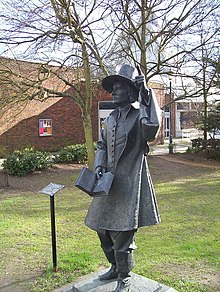Samuel Stone
Samuel Stone (July 18, 1602 – 20 July 1663) was a Puritan minister and co-founder of Hartford, Connecticut.
Stone was born in the town Hertford, in the county of Hertfordshire, England. In 1620, he left Hertford to study at Emmanuel College, Cambridge, from where he graduated in 1624.[1] He was ordained on July 8, 1626 at Peterborough and a year later became curate at Stisted, Essex.[2] In 1633, Samuel Stone and Thomas Hooker sailed across the Atlantic on a ship named the Griffin. They arrived in Boston on the 4th of September of the same year, and a few weeks later, Samuel Stone became a Teacher of the Cambridge Church under Hooker, who was the preacher.[3] In 1644, he became a Freeman.[2] In 1636, Stone and Hooker led their congregation from New Towne (now Cambridge, Massachusetts) and established a new colony at House of Hope (a Dutch fort and trading post), making peace with the local Indians and renaming the town they called Saukiog as Hartford, after Stone's birthplace - they thus became the town's founding fathers.
Stone was twice married. By his second wife, Elizabeth Allyn, whom he wed in 1641, he had four (4?) surviving children—a son Samuel and four daughters, Elizabeth, Rebecca, Mary and Sarah. He published “A Congregational Church, a Catholike Visible Church” in London in 1642, in answer to Samuel Hudson's "Visible Catholick Church [4] and left two works in manuscript: a catechism and a confutation of the Antinomians. Records show that he was an active buyer and seller of land in Hartford. [5][6][7]
There is a statue of Samuel Stone in the centre of Hertford, Hertfordshire.[8]

References
- ^ "Stone, Samuel (STN620S)". A Cambridge Alumni Database. University of Cambridge.
- ^ a b "Archived copy". Archived from the original on 2007-09-27. Retrieved 2007-06-29.
{{cite web}}: Unknown parameter|deadurl=ignored (|url-status=suggested) (help)CS1 maint: archived copy as title (link) - ^ See Calvin's Institutes for the distinctions between these two functions in Reformed thinking and practice.
- ^ Stone, Samuel. "A vindication of the essence and unity of the church-catholick visible". Retrieved 19 April 2017.
- ^ John Winthrop (1853). History of New England,. p. i 108,109,115,142,235;.
{{cite book}}: CS1 maint: extra punctuation (link) - ^ Cotten Mather (1853). Magnalia Christi Americana,. p. i 434–8.
- ^ Appleton's Cyclopaedia of American Biography. 1887. p. v. 703.
- ^ "Statue - Samuel Stone - Go Hertford".
External links
- . Dictionary of National Biography. London: Smith, Elder & Co. 1885–1900.
